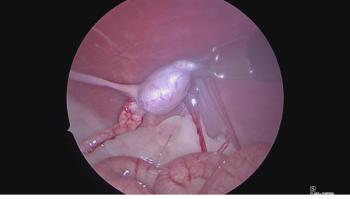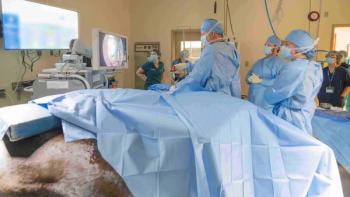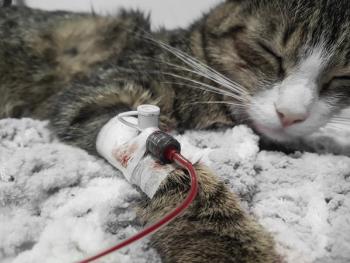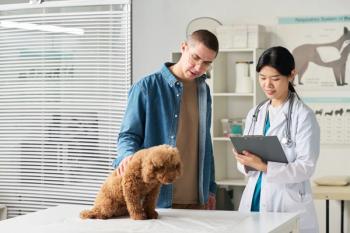
- dvm360 September 2022
- Volume 53
- Issue 9
- Pages: 38
Understanding laparoscopy in veterinary surgery
General practitioners are incorporating this increasingly common minimally invasive surgery into their menu of services
Georg Kelling performed the world’s first laparoscopic procedure in 1901, and like many medical firsts, that procedure was performed on a canine. Fast-forward 121 years to the present day: Laparoscopic surgery has become the standard of care for most surgical procedures in human medicine and is now being supplemented with robotic surgery.
Laparoscopic surgery, sometimes referred to as keyhole surgery or minimally invasive surgery (MIS), involves the use of high-quality telescopes connected to a digital video camera. The camera is attached to a fiber-optic cable and light source, which then relays the images to an associated monitor.
To create enough working space for organ and instrument manipulation, the peritoneal cavity is insufflated with carbon dioxide to move the abdominal wall away from the internal organs. Peritoneal access is typically obtained with a specialized instrument called a Veress needle, which is placed blindly into the peritoneal cavity to establish the pneumoperitoneum, or with a modified Hasson technique, allowing direct visualization of peritoneal access.
Although we are many years away from robotic surgery being readily available in veterinary medicine, laparoscopy has been growing rapidly over the past 20 years, with many purposes in veterinary surgery (see Figure). It is available in most specialty hospitals, and many general practitioners are incorporating laparoscopy into their practices. It has grown to the point that a subspecialty fellowship program within the American College of Veterinary Surgeons is dedicated solely to advanced training in soft tissue MIS.
Using the right tools
The laparoscopic procedure may be performed with multiple trocars placed through small incisions (multiple-port laparoscopy) or with a single incision using a port device, allowing the use of multiple ports within it (single-port laparoscopy). The decision on which technique to use will depend on surgeon preference and the nature of the procedure to be performed.
Most surgical instruments today are available in laparoscopic form and typically come in 5-mm or 10-mm diameters. The instruments have shafts covered with an insulated sheath, allowing for concurrent use with monopolar electrocautery and optimizing them for laparoscopic application. Articulating forms of certain instruments are also available, which can improve triangulation.
In addition to normal instruments, numerous specialized devices have dramatically increased the number and complexity of procedures performed laparoscopically. Examples of these devices include endoscopic staplers, specimen retrieval bags, and bipolar vessel sealing devices. Most veterinary surgeons would proclaim the last of these tools an absolute necessity for most laparoscopic procedures.
Demonstrating benefits to patients
The advantages of laparoscopic surgery are well known and have been demonstrated through multiple veterinary studies. Laparoscopic surgery has been associated with decreased pain compared with that of traditional open surgery1,2 and a more rapid return to normal activity.3,4 In addition, some literature suggests that the postoperative wound infection rate may be lower with minimally invasive approaches.5
More recent studies have shown that cholecystectomy, a daunting procedure not without significant complications, can be performed laparoscopically with minimal morbidity and mortality rates with appropriate patient selection.6 Additionally, some procedures such as adrenalectomy have been performed faster laparoscopically when compared with a traditional open method.7
Downsides for practices
As with all things, laparoscopy has its disadvantages. These include increased procedural times, increased cost of specialized equipment, and the requirement for specialized training in MIS. However, these disadvantages can be offset by surgeon experience and increased availability of training opportunities, such as the international Veterinary Assessment Laparoscopic Skills program.
A growing market
The number of procedures that can be performed laparoscopically has increased significantly. More routine procedures such as ovariectomy, liver biopsy, and laparoscopic-assisted gastropexy are commonly performed and may be done with minimal specialized instrumentation.
With the advent of barbed suture material, gastropexies may be performed totally laparoscopically, as this mate- rial significantly reduces the challenge of intracorporeal suturing. The introduction of 4K high-definition monitors and near-infrared imaging allow for breathtaking image quality and the ability to highlight abnormal tissue that would not normally be visible.
With continued advancements in medicine and technology, the future will bring even more possibilities to the world of MIS. Hopefully these advancements will find their way into veterinary medicine, where it all started.
Justin Ganjei, DVM, DACVS-SA, is a staff surgeon at Veterinary Surgical Centers in Vienna, Virginia, and an adjunct assistant professor of small animal surgery and minimally invasive surgery at the Virginia-Maryland College of Veterinary Medicine in Blacksburg, Virginia.
References
- Devitt CM, Cox RE, Hailey JJ. Duration, complications, stress, and pain of open ovariohysterectomy versus a simple method of laparo- scopic-assisted ovariohysterectomy in dogs. J Am Vet Med Assoc. 2005;227(6):921. doi:10.2460/javma.2005.227.921
- Walsh PJ, Remedios AM, Ferguson JF, Walker DD, Cantwell S, Duke T. Thoracoscopic versus open partial pericardiectomy in dogs: comparison of post-operative pain and morbidity. Vet Surg. 1999;28(6):472. doi:10.1111/j.1532-950x.1999.00472.x
- Culp WTN, Mayhew PD, Brown DC. The effect of laparoscopic versus open ovariectomy on postsurgical activity in small dogs. Vet Surg. 2009;38(7):811-817. doi:10.1111/j.1532-950X.2009.00572.x
- Mayhew PD, Brown DC. Prospective evaluation of two intracorporeally sutured prophylactic laparoscopic gastropexy techniques compared with laparoscopic-assisted gastropexy in dogs. Vet Surg. 2009;38(6):738. doi:10.1111/j.1532-950X.2009.00554.x
- Mayhew PD, Freeman L, Kwan T, Brown DC. Comparison of surgical site infection rates in clean and clean-contaminated wounds in dogs and cats after minimally invasive versus open surgery: 179 cases (2007-2008). J Am Vet Med Assoc. 2012;240(2):193-198. doi:10.2460/javma.240.2.193
- Kanai H, Hagiwara K, Nukaya A, Kondo M, Aso T. Short-term outcome
of laparoscopic cholecystectomy for benign gallbladder diseases in
76 dogs. J Vet Med Sci. 2018;80(11):1747-1753. doi:10.1292/jvms.18-0266 - Taylor CJ, Monnet E. A comparison of outcomes between laparoscopic and open adrenalectomies in dogs. Vet Surg. 2021;50(suppl 1):O99-O107. doi:10.1111/vsu.13565
Articles in this issue
about 3 years ago
We DO talk about Bruno (and Clifford and Wininger)about 3 years ago
Dream team creates their ideal veterinary clinicabout 3 years ago
The Dilemma: Whom should I hire?about 3 years ago
5 questions to answer if you’re considering practice managementabout 3 years ago
What to know before taking out a loan to purchase a practiceover 3 years ago
Team building is crucial to a successful practiceover 3 years ago
Managing acral lick dermatitis in caninesover 3 years ago
Island displays human-animal bond at its bestNewsletter
From exam room tips to practice management insights, get trusted veterinary news delivered straight to your inbox—subscribe to dvm360.




